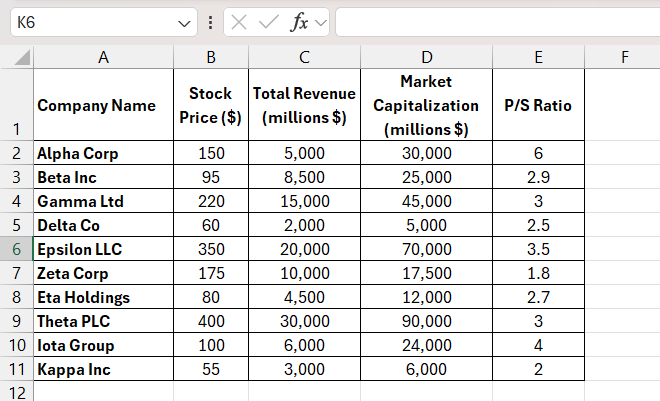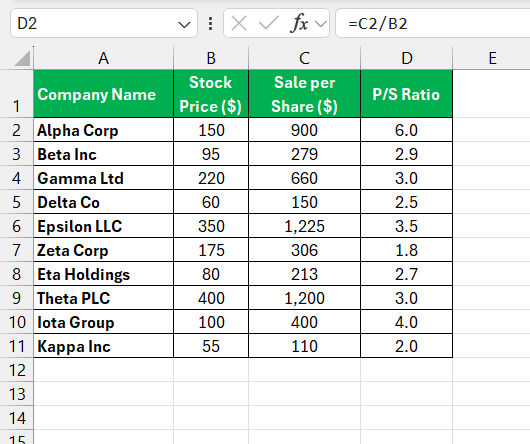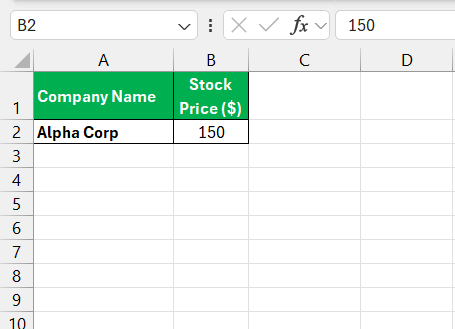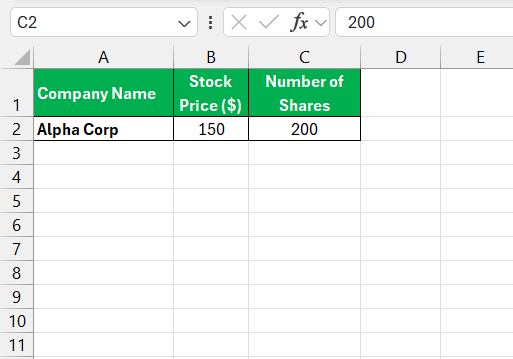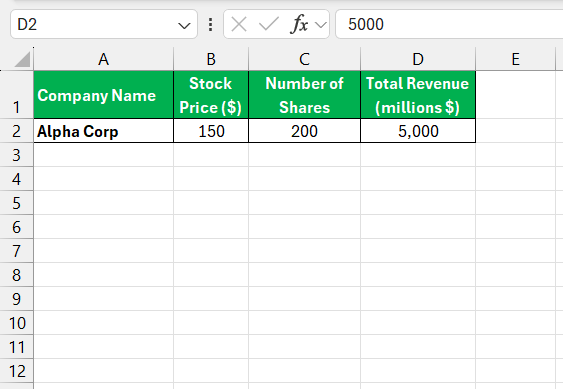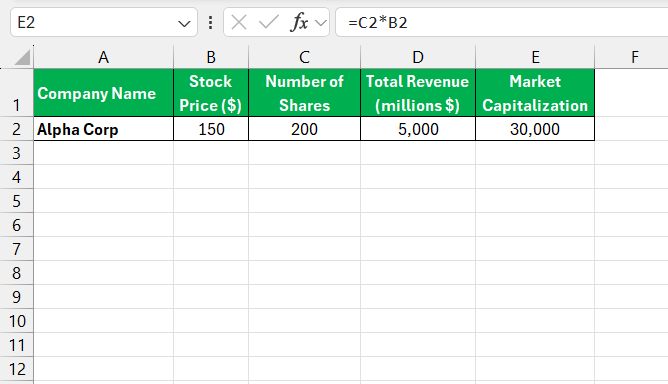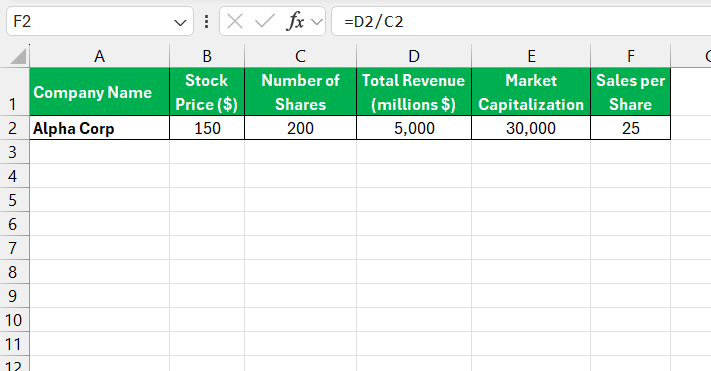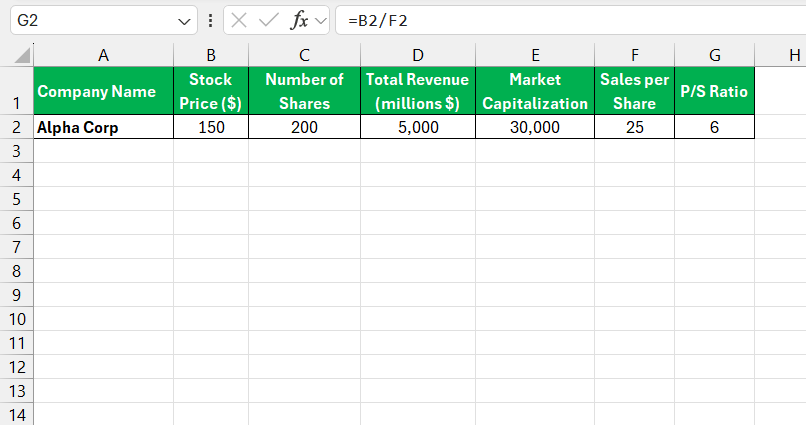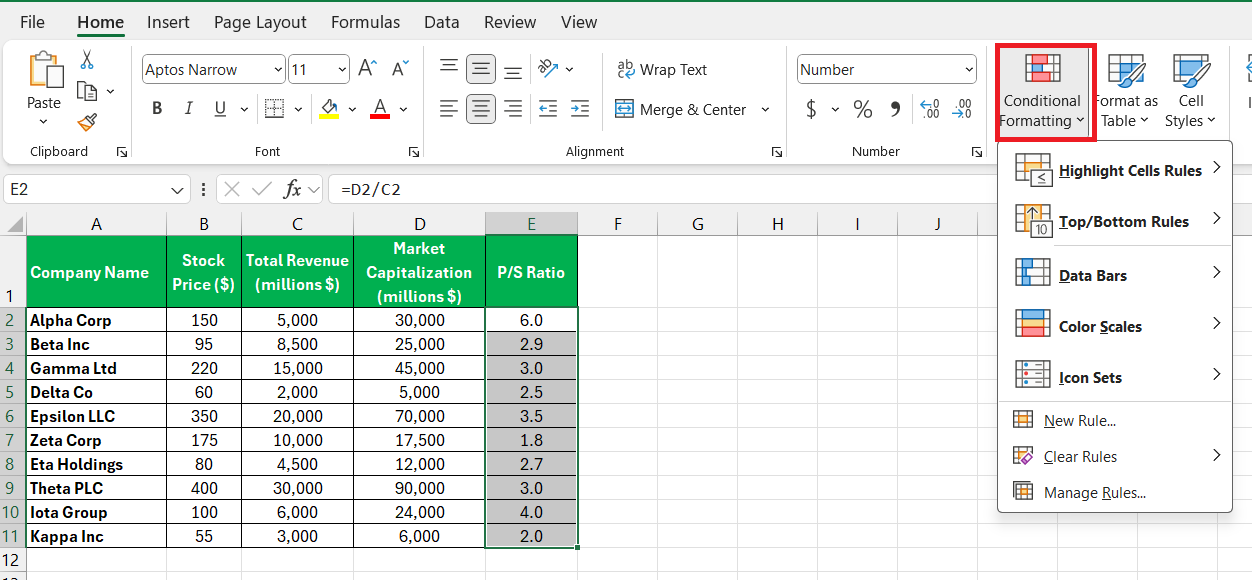When evaluating a company’s valuation, the price-to-sales (P/S) ratio is an essential metric for understanding the relationship between a company’s stock price and its revenue. In this article, I’ll walk you through the basics of the price-to-sales ratio, how it’s calculated, and—most importantly—how to quickly compute it in Excel.
Key Takeaways:
- The price-to-sales (P/S) ratio compares a company’s stock price to its revenue, helping investors gauge a company’s value.
- Unlike other metrics, the P/S ratio is focused on revenue, making it less influenced by accounting practices or profitability.
- In Excel, you can easily calculate the P/S ratio by dividing the market cap by revenue or price per share by sales per share.
- P/S ratios vary by industry, so comparing within the same sector is key to accurate valuation.
- The P/S ratio doesn’t consider debt or profitability, so it’s best used with other financial metrics for a fuller picture.
Table of Contents
Unveiling the Essentials of Price to Sales Ratio
Definition and Significance in Valuation
The price to sales ratio (P/S) is a valuation metric that compares a company’s stock price to its revenue. It plays a crucial role in determining how investors and analysts perceive the relative value of a company, particularly in comparison to its peers. A lower P/S may suggest that a company is undervalued relative to its sales, while a higher P/S might indicate overvaluation.
This ratio becomes particularly significant in industries where earnings are not the sole driver of stock prices, offering a different dimensional insight into a company’s worth.
Key Distinctions from Other Financial Ratios
When we consider other financial ratios, the P/S ratio stands out due to its focus on sales as opposed to profits or assets. Unlike the price-to-earnings (P/E) ratio which centers on net income, the P/S ratio provides an evaluation that is less affected by accounting practices and tax strategies, which can sometimes mask the true financial performance of a company.
It’s different from the price-to-book (P/B) ratio, where balance sheet assets are the benchmark—this can be influenced by depreciation methods and other non-cash factors. Liquidity and solvency ratios, on the other hand, gauge a company’s ability to meet short-term and long-term obligations, respectively, but they don’t offer insights into how the market values the company’s sales revenue as the P/S ratio does.
Steering Through the Formula Landscape
The Mathematical Blueprint for P/S Calculation
The calculation of the P/S ratio follows a straightforward mathematical formula:
Price-to-Sales Ratio = Market Capitalization/Total Revenue
To decipher this, you simply take the current market cap of a company—obtained by multiplying the current stock price by the total number of outstanding shares—and divide it by the company’s total revenue over a specified period.
The revenue figure should be taken from the company’s income statement, and the comparison of market valuation to actual sales generated should be ensured. By using this formula, we gauge the dollar amount investors are willing to pay for each dollar of sales, giving us a sense of the market’s valuation of the company in terms of its sales.
Variations in Calculating Price to Sales Ratio
While the fundamental approach to calculating the P/S ratio is rather standardized, variations do emerge based on the time frame of sales data used and the method of expressing sales revenue. Investors might opt for annual sales numbers to understand long-term performance or scrutinize quarterly data for a more immediate glance at a company’s trajectory. Similarly, some may prefer to calculate the P/S ratio using sales per share:
P/S Ratio = Price Per Share/Sales Per Share
Here, the focus is on per-share values, providing an individualized slice of the company’s sales pie. This can be insightful when comparing companies of different sizes within the same industry. Whether examining overall market capacity or per-share data, investors can adapt the calculation to fit the context of their analysis for a more tailored understanding of a company’s sales efficiency.
Excel as Your Financial Co-Pilot
Crafting a Price to Sales Calculator in Excel
Creating a P/S ratio calculator in Excel streamlines the process of assessing a company’s market valuation in relation to its sales. To craft one, start by gathering the necessary data: the stock’s current price and the company’s most recent sales figures. Here’s a step-by-step guide:
STEP 1: In one cell, input the stock’s current price.
STEP 2: Enter the total number of shares outstanding in a separate cell.
STEP 3: In a third cell, provide the company’s total revenue over the chosen time frame.
STEP 4: Now, calculate the market capitalization by creating a formula that multiplies the stock price with the number of shares.
STEP 5: To get the Sales Per Share, divide the total revenue by the number of shares outstanding.
STEP 6: Lastly, compute the P/S ratio by dividing market cap by total revenue or price per share by sales per share, depending on your chosen method.
This Excel calculator can become a powerful tool to quickly compare the P/S ratios of different companies or to monitor changes in a single company’s ratio over time. Remember to ensure that all figures are for the same time period to maintain consistency.
Tips and Tricks for Efficient Excel Formulas
Maximizing efficiency in Excel is key for financial analysis. To optimize your formulas when working with the P/S ratio, consider these tips:
- Use Named Ranges: Rather than referring to specific cell coordinates, name the cells containing stock price, shares outstanding, and total revenue. This way, formulas become more readable, like
=MarketCap/TotalRevenue.
- Leverage Excel Tables: By converting your data range into a table, you can ensure your formulas automatically adjust when new data is added. This dynamic expansion saves time and reduces errors.
- Apply Conditional Formatting: Highlight P/S ratios that indicate undervaluation or overvaluation criteria you’ve set, making them stand out for quick analysis.
- Utilize Excel Functions: Functions like
SUMIFSorAVERAGEIFScan be beneficial if you’re handling a dataset with multiple companies or time periods. - Create Data Validation Rules: Use data validation to prevent entry errors. For instance, ensure that revenue and share figures are positive numbers.
- Keyboard Shortcuts: Mastering shortcuts for actions like copying formulas down a column (
Ctrl+D) or across a row (Ctrl+R) can significantly speed up your workflow.
Incorporating these Excel practices not only boosts your ability to calculate the P/S ratio but also enhances overall productivity when maneuvering through any financial analysis.
Interpreting the Numbers
What Does a Good Price to Sales Ratio Look Like?
A good price to sales ratio often depends on the industry and the company’s growth phase. Typically, a P/S ratio ranging from 1 to 2 might suggest that the company’s value is in line with its sales. However, a lower P/S ratio, say below 1, might indicate that the stock is undervalued based on its sales. On the flip side, a higher P/S ratio could also suggest that the company is overvalued, but this isn’t a hard and fast rule.
For growth companies, especially in technology or biotech sectors, investors may tolerate higher P/S ratios due to the expectation of rapid sales growth. Conversely, for established firms in more traditional industries, a lower P/S is often more desirable as it may reflect more stable and predictable sales patterns. Always compare P/S ratios among similar companies in the same sector for a more accurate assessment.
Analyzing Outliers: When High or Low P/S is Deceptive
High or low P/S ratios may sometimes be misleading. A low P/S ratio could appear attractive but it might signal underlying issues such as declining industry prospects or company-specific challenges affecting sales growth potential. Conversely, a high P/S ratio might seem excessive but could be justified for companies with robust growth prospects, innovative technologies, or strong competitive moats.
To analyze these outliers, we must dig deeper. We should consider the company’s future revenue-generating ability, its market position, and the overall health of its industry. Evaluating broader economic factors and market trends is also crucial to understand whether a high or low P/S ratio is justified. Thus, while P/S is a useful starting point, it should be one of the many tools in a comprehensive toolkit for evaluating a company’s true investment potential.
Real-World Applications
Case Study: Applying P/S Ratio for Investment Decisions
In a case study I examined, the P/S ratio proved instrumental in the investment decision for a burgeoning tech startup. The startup showcased skyrocketing sales yet operated at a net loss, rendering the P/E ratio useless. However, the P/S ratio revealed that its market cap was only twice its annual sales, indicating potential undervaluation given its growth trajectory.
Upon further analysis, comparing its P/S ratio to established players in the industry and taking into account its innovative product pipeline, the decision to invest was clear. Over the following year, the startup’s market share expanded, affirming the initial assessment based on its attractive P/S ratio. This case underscores the importance of contextualizing P/S ratio analysis within the broader market and company-specific dynamics to make informed investment decisions.
Sector-by-Sector Analysis: Understanding Industry Norms
Cross-sector comparison of P/S ratios can be like comparing apples to oranges due to inherent differences in how each industry generates and scales revenue. For instance, high-tech companies might consistently flaunt higher P/S ratios reflective of their growth expectations and scaling potential. In contrast, utilities typically showcase lower ratios, characterized by stable revenue streams and regulated growth environments.
Understanding industry norms is pivotal. Retail might average a P/S ratio around 0.5 to 0.8, indicating that investors are willing to pay less for each dollar of sales, reflecting thinner profit margins. In contrast, a software company could command a ratio exceeding 5, suggesting investors’ confidence in higher future earnings despite current price premiums.
When considering P/S ratios, I always compare within the same industry, aiming to benchmark against the median or average industry ratios. This targeted approach provides a clearer picture of where a company stands amongst its peers and whether its stock might be undervalued or overvalued in the market.
Overcoming Common Hurdles
Limitations of the Price to Sales Ratio
The price-to-sales ratio, while a handy tool, isn’t flawless. One of its primary drawbacks is that it only considers revenue, disregarding the cost structure and profitability of a company. A low P/S ratio doesn’t automatically translate to value; it might merely reflect inefficiencies or thin profit margins. Moreover, the ratio doesn’t account for debt—two companies with the same P/S ratio could have vastly different risk profiles if one is heavily leveraged.
Another limitation is that the P/S ratio can vary widely across industries, making cross-sector comparisons potentially misleading. Additionally, it neglects the operational effectiveness, where companies with identical sales could have different margins and cash flows due to their operational management. Due to these factors, relying solely on the P/S ratio when making investment decisions can be risky, and it’s advisable to use it in conjunction with other metrics such as P/E ratios, debt-to-equity ratios, and free cash flow analyses.
FAQs
What is the price to sales ratio?
The price to sales ratio is a financial metric that compares a company’s stock price to its revenue. It reflects how much investors are willing to pay for a dollar’s worth of a company’s sales. By providing an intuitive measure of market valuation relative to revenue, it’s a popular tool in the realms of investment analysis and valuation, particularly for companies that aren’t yet profitable or for industry segments where sales growth is a prominent metric.
What is the formula for price to sales ratio?
The formula for the price to sales ratio is either:
Price-to-Sales Ratio = Market Capitalization/Total Revenue
OR on a per-share basis:
Price-to-Sales Ratio = Price Per Share/Sales Per Share
This formula calculates the value the market is assigning to each dollar of a company’s sales, offering an indication of how the market prices the company’s revenue stream.
How can I ensure accuracy in my P/S ratio calculations in Excel?
To ensure accuracy in P/S ratio calculations in Excel, double-check that you’re using the most recent and relevant financial data. Use named ranges or tables for clarity and to minimize mistakes, and apply consistent formulas across your dataset. It’s also wise to cross-reference your results with reliable financial information sources and keep a record of your sources for future validation.
What are some mistakes to avoid when using the P/S ratio for investment analysis?
When using the P/S ratio for investment analysis, avoid interpreting it in isolation, as it doesn’t account for profitability or debt. Be cautious about sector comparisons given differing business models. Also, ensure you use consistent time frames and accurate data to avoid skewed results. Remember that a low P/S does not always mean a stock is undervalued, nor does a high P/S invariably point to overvaluation.
What is a good price-to-sales ratio?
A good price-to-sales ratio can vary by industry, but traditionally, a P/S below 1 might suggest potential undervaluation, while above 2 could imply overvaluation. Yet, for high-growth sectors, higher ratios are common. Always contextualize P/S ratios within industry and company growth profiles before making investment decisions.
John Michaloudis is a former accountant and finance analyst at General Electric, a Microsoft MVP since 2020, an Amazon #1 bestselling author of 4 Microsoft Excel books and teacher of Microsoft Excel & Office over at his flagship MyExcelOnline Academy Online Course.

